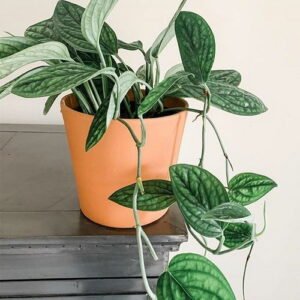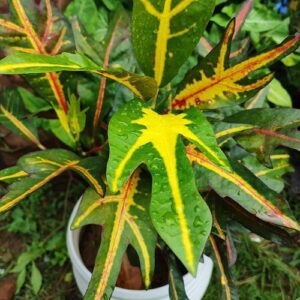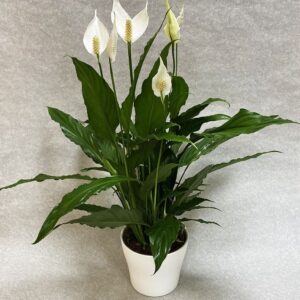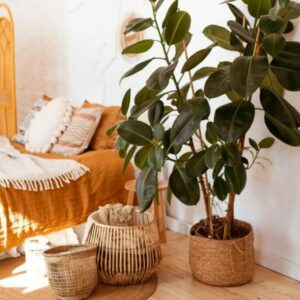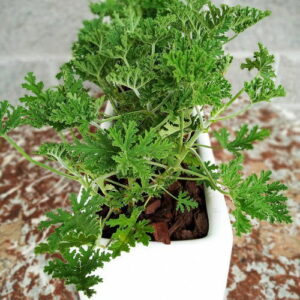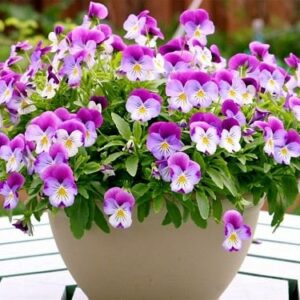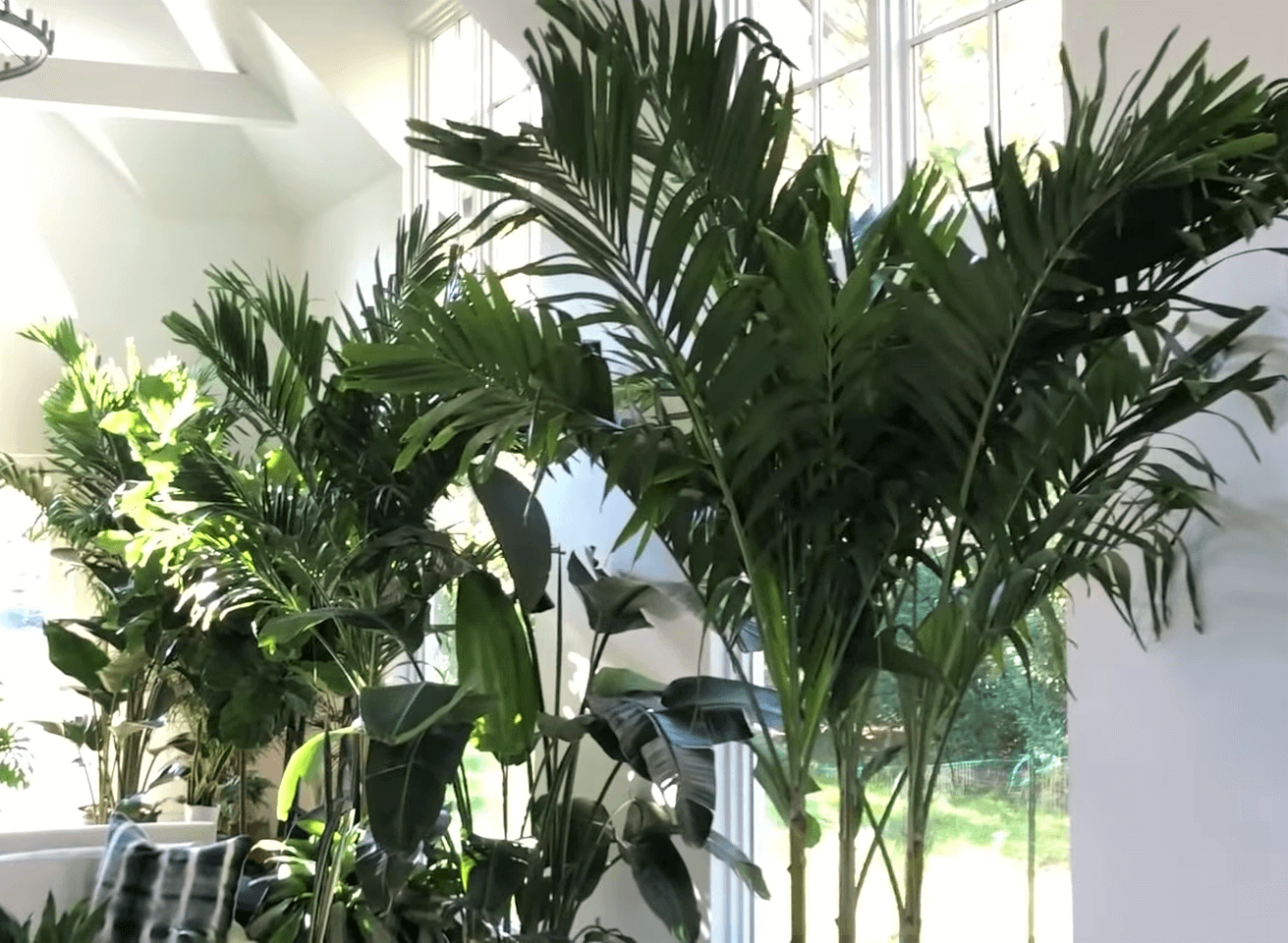
Growing indoor houseplants has become a trend that will stay with us for a very long time. But there is even a better way to make a bold décor statement – growing large indoor plants.
Large houseplants are not only good for your health, but offers a great way to add some much needed color and texture.
In addition, you can use them in a variety of indoor décor themes especially in the living room corners where you have tall walls and bright light.
If you are looking for the best large indoor plants to finally style your house while making a statement with your décor, then you will definitely love this article.
You’ll find three important pointers under each houseplant; note (plant not toxic), caution (plant toxic to pets and or humans), and pro tip (important point(s) to remember).
Sounds epic, right?
Let’s get started:
The Best Large Indoor Plants For Your Home Décor
1. Rubber plant (Ficus elastica)
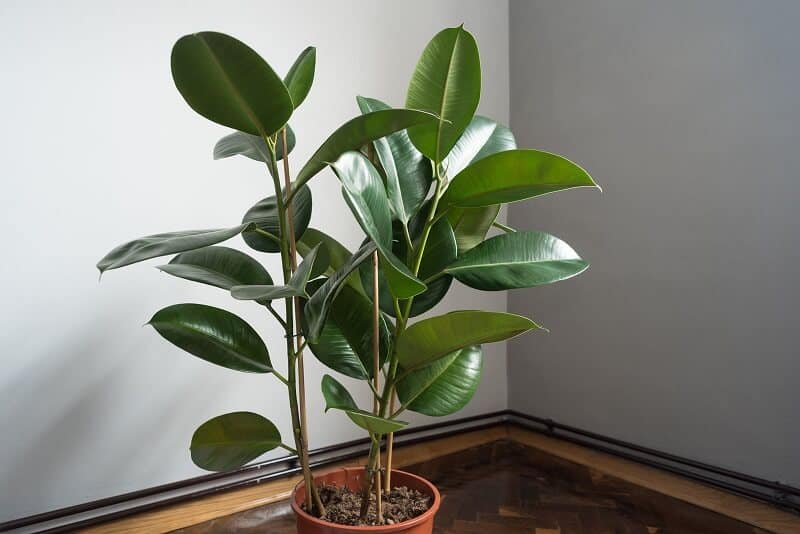
This is definitely a plant that you wouldn’t want to miss in your living room.
With its large, deep green, variegated or glossy leaves and a vertical growing nature, rubber plant not only brings a sense of sophistication to casual spaces, but also softens modern rooms.
Rubber plants are easy to grow hence with well aerated and good draining potting soil, the plant will not disappoint.
Try using 1-part peat, 1-part pine bark and 1-part coarse sand (or perlite) for better performance.
Also ensure that your plants receive moderate to bright light, but never direct sun.
Feed your plant with a diluted liquid fertilizer every two weeks during spring and summer to keep it healthy.
Maintain the glossy clean dust free look by cleaning your plants using a sponge or soft cloth and tepid water.
The most common indoor varieties includes; F.elastica decora, F.elastica robusta and F.elastica black prince/burgundy.
Caution: Ficus elastica is not safe to both pets and humans. Take care not to ingest neither should your pets.
Buy Houseplants online at: Amazon.com
2. False Aralia plant (Schefflera elegantissima)
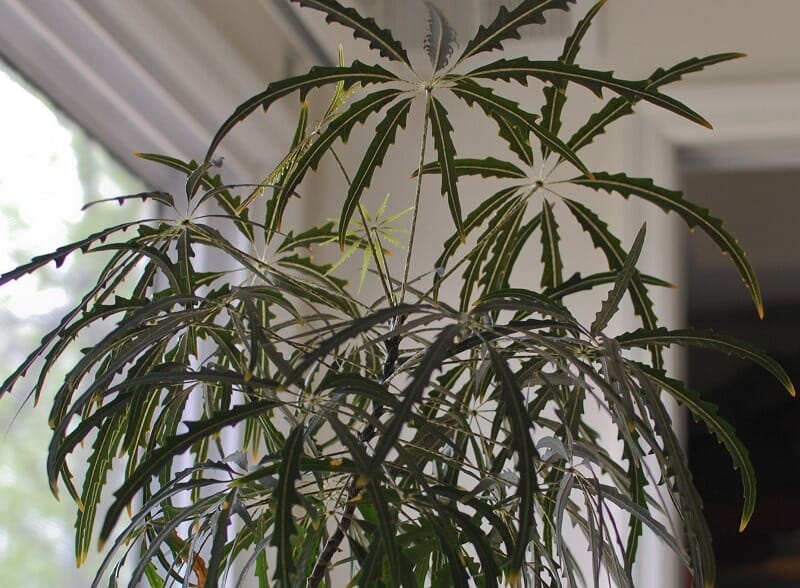
False Aralia is a small evergreen tree that provides a tropical look to indoor settings.
Due to its upright, vertical characteristic, False Aralia is best used as an accent or specimen plant.
This indoor plant performs best in light shade but can tolerate bright light also. With fertile, well-drained soil, as well as proper watering regime, the plant will thrive well.
Check that the top of soil is completely dry or the plants are wilted before watering.
Just like any other indoor plant, it is important to feed your Aralia plant with a slow release fertilizer at least once in a season to improve on nutrition.
Note: False Aralia is safe for pets and horses.
3. Fishtail palm (Caryota)
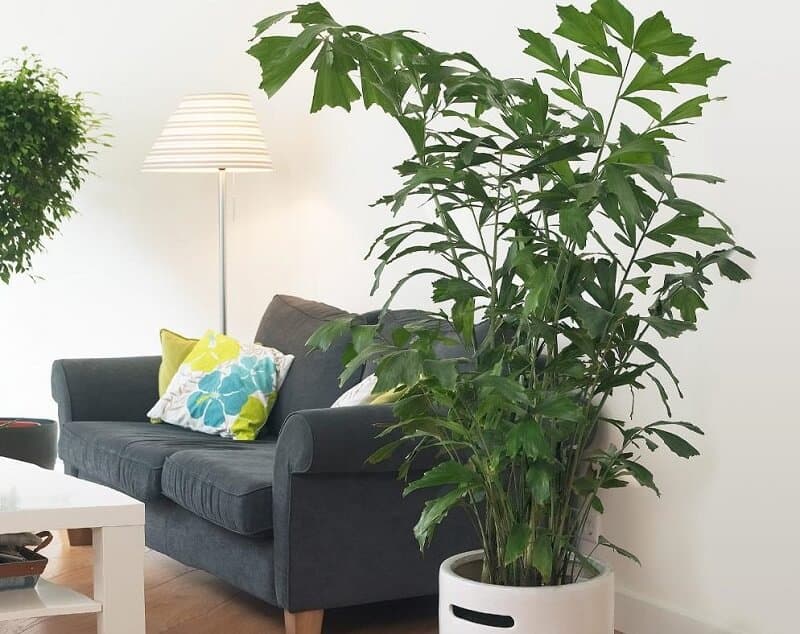
With its unique profile of fishtail-like leaves, this tropical houseplant transforms any setting into a fancy tropical look.
Fishtail palms can tolerate different soil types ranging from loamy, sandy, clay, acidic as well as alkaline.
Regardless of the type of potting mix, make sure that it’s well drained. Just like all palms, fishtail palm has specific nutritional needs.
Feed your plants using a palm fertilizer at the rates recommended on the label.
It is recommended that you water the palms first before applying fertilizer to help prevent root-burn by fertilizer salts.
Expose your plants to moderate to bright light for better performance.
Caution: Fishtail palm contains needle-like calcium oxalate crystals. If chewed or eaten, these crystals can produce a burning sensation in the mouth. Also, skin contact can result in burning, itching and dermatitis.
4. Norfolk Island Pine (Araucaria heterophylla)

Norfolk Island Pine is a tropical plant with softer and more delicate needles.
This slow growing houseplant tolerates low to high light and, prefers relatively moist soil. (not too wet or too dry)
Just by the fact that it’s a tropical plant, Norfolk Island pine needs high humidity to thrive.
Hence, keep the humidity around the tree high by either using a humidifier or a pebble tray with water.
It is also recommended that you apply a diluted liquid fertilizer from spring through fall once or twice a week to enhance plant development.
Caution: Norfolk pine is toxic to cats and dogs.
5. Corn Plant (Dracaena fragrans)
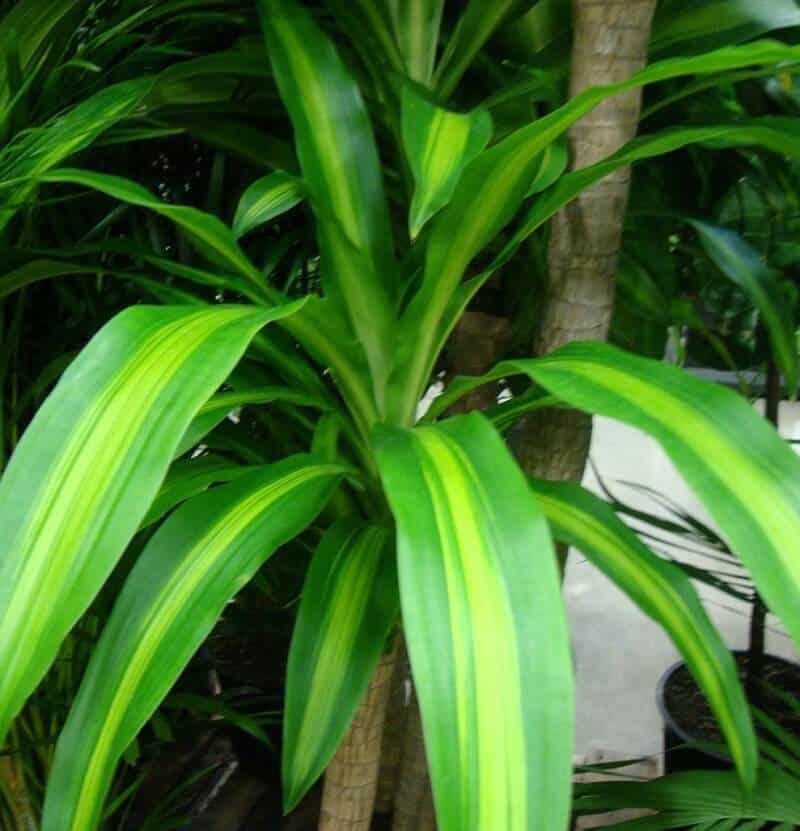
This slow growing indoor plant has its unique way of making a statement in any room. With its pretty display of bright leaves as well as its geometrically shaped trunk.
Corn plant leaves are also good at indoor air purification.
Dracaena fragrans thrives in lower light levels so, keep it in bright to moderate filtered light indoors.
Avoid exposing the plants to direct sun as the foliage might burn. Too low light levels cause the leaves to narrow so, you should avoid that too.
This plant survives under-watering but quickly dies from over-watering thus, water only when the top soil is completely dry. Drainage is very important for this plant.
Feed your dracaena once a month in the spring and summer with a balanced plant food diluted to 1/2 the recommended strength.
Additionally, fertilize the plant only once during the Fall for a healthy, beautiful plant.
Pro Tip: Never feed a dracaena during the winter as it is the plant’s time to rest.
Caution: Dracaena fragrans is not safe for cats, dogs and horses. Take care.
6. Lacy Leaf Philodendron (Philodendron bipinnatifidum)
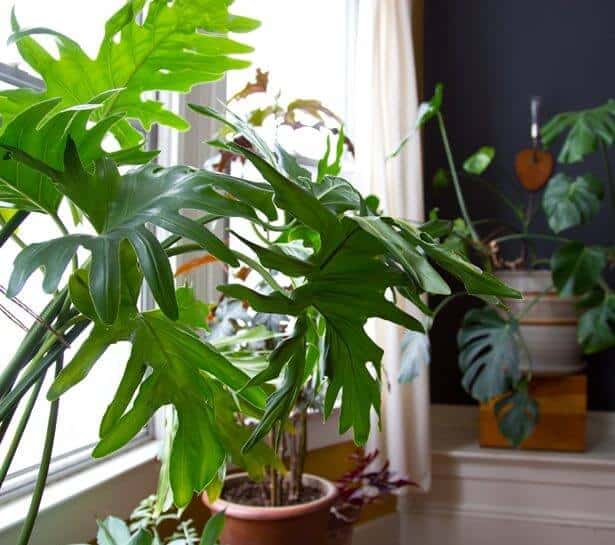
Lacy leaf philodendron is a huge glossy- leaved easy to grow indoor plant with the ability of stretching to as much as 6 feet wide.
This indoor plant can remove air pollutants such as formaldehyde, benzene from interior environments.
The plant loves moderate light and enough moisture. So, water your plant only when the top of the soil dries.
This indoor plant is salt sensitive and prefers organic soil/ potting mix that is slightly acidic.
Caution: Philodendron Bipinnatifidum is toxic to both cats and dogs.
Learn how to grow Pink Princess Philodendron
7. Swiss Cheese Plant (Monstera deliciosa)
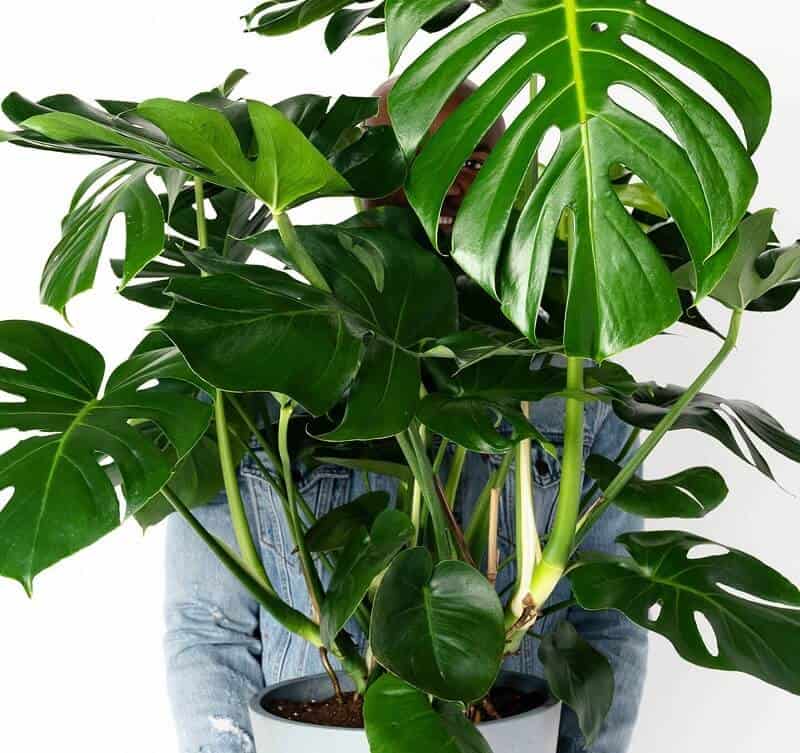
An easy to grow indoor plant with huge cut foliage and stems.
This tropical indoor plant is able to make a huge impact on the interior of any home. Swiss cheese plant is intolerant of direct sunlight and wet soil.
For this reason, place your plants at spaces with moderate light and average humidity.
In addition, use a rich, well-drained soil that is not allowed to dry out completely. Alternatively, use a good soilless recipe as it also works well.
Feed your plants with any houseplant feed at normal strength not more than once a month during periods of active growth.
This helps the plant to produce new, lush green growth.
Caution: Swiss cheese plant roots and leaves are toxic to pets and humans.
8. Giant Bird of Paradise (Strelitzia nicolai)
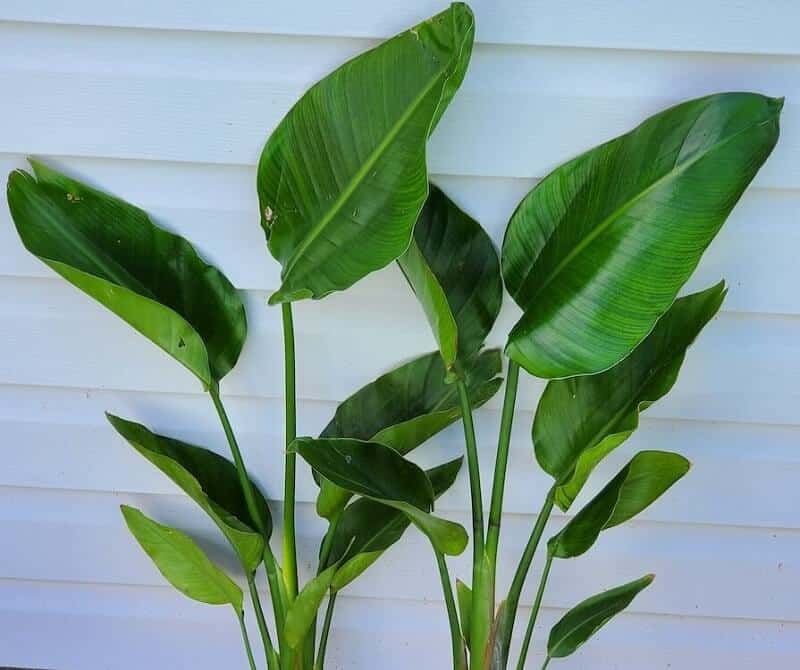
Bird of Paradise are tropical broad-leaved houseplants very common in many households.
Strelitzia Nicolai is tolerant to well drained clay, loamy, sandy, slightly alkaline as well as acidic soils.
These plants are also tolerable to part shade/part sun and full sun. Place your plants in a room with enough light. Preferably 4- 5 hours of sunlight for best performance.
Always water your plants well and do not let the soil get soaked or dry completely.
Caution: Strelitzia nicolai is non- toxic to humans (According to the University of Connecticut) but, its toxic to cats, dogs and horses (According to the ASPCA)
9. Umbrella Tree (Schefflera amata)
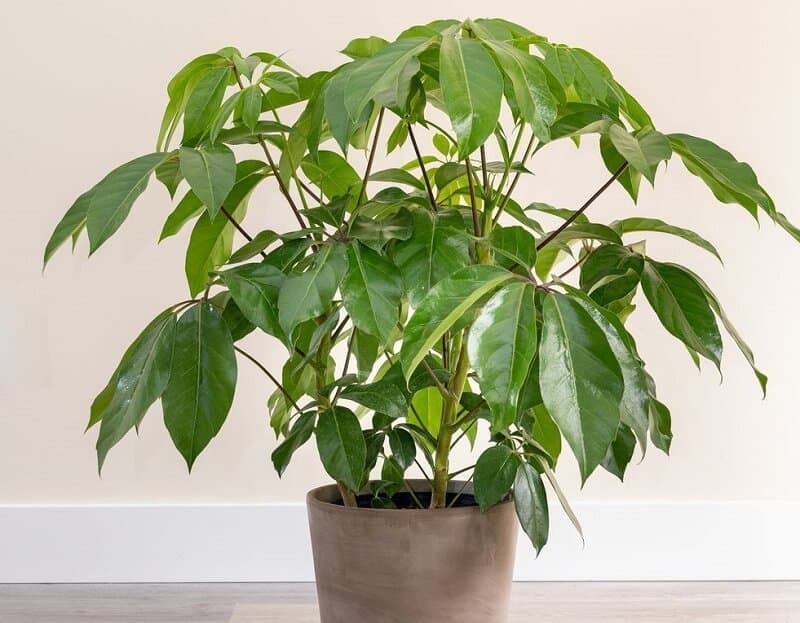
Umbrella tree is the larger-leaf version of the classic umbrella plant. This easy to care houseplant needs standard watering and medium to bright indirect light.
When watering, make sure the soil is thoroughly watered and the excess is allowed to drain off. It’s best to keep the plant on the dry side as wet soil can cause root rot.
During spring, feed your umbrella tree with a Liquid kelp or fish emulsion diluted to half strength.
A balanced liquid houseplant fertilizer (5-5-5 or lower) also works well. Carry out another application in summer if your S. amata needs one.
Do not over fertilize the plants as this may lead to salt build-up and eventual plant death.
Also do not fertilize houseplants in late fall or winter because that’s their time to rest.
Caution: Schefflera contains toxins potentially harmful to people and animals.
10. Fiddle Leaf Fig (Ficus lyrata)
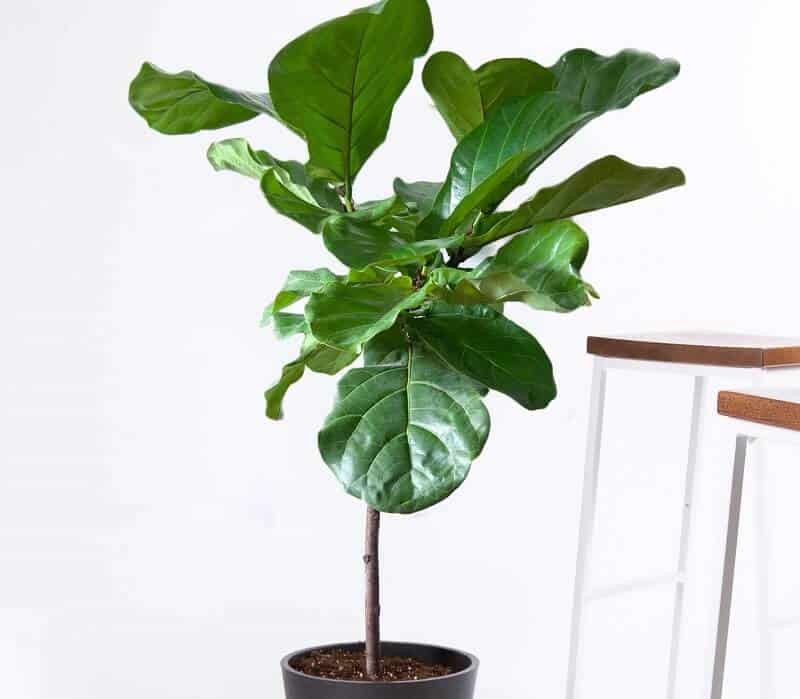
Fiddle leaf figs are tall broad- leaved large indoor plants that add a beautiful touch to your room or office.
Although these plants aren’t easy to keep alive, more of tolerance, love and care helps them survive.
These indoor plants are suited for different types of lighting hence can withstand both direct and indirect sunlight.
Regularly water the plants and at the same time, avoid overwatering. Unlike some other ficus trees, the ficus lyata does not have a strong need for fertilizer.
Give the plants a feed of diluted liquid fertilizer once a month during spring and summer. Alternatively, use Fiddle Leaf Fig Organic Fertilizer Spikes
Pro Tip: Fiddle leaf fig takes a long time to grow big. If you want faster results, start with a bigger plant. Once you’ve established the location, do not move the plants around as the leaves may fall off.
Caution: Fiddle leaf fig is toxic to both humans and animals. Do not ingest or let your pets chew on it.
11. Yucca (Yucca elephantipes)
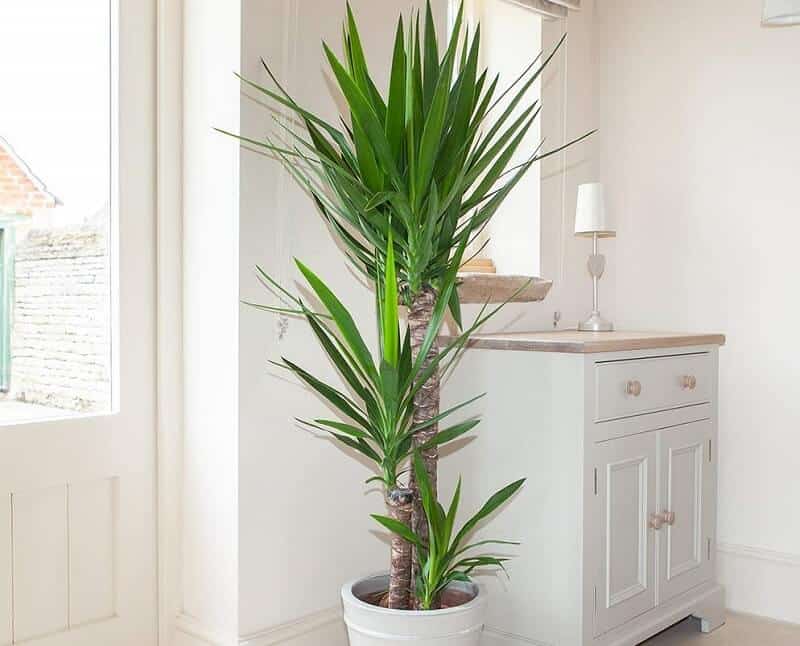
This drought tolerant plant is not only great at adding a desert look to your room but also good at indoor air filtration.
Yucca is an easy to care drought resistant plant which need watering only when the soil is dry.
Additionally, this plant is tolerable to a wide range of soils including; clay, loamy, sandy, acidic, and alkaline.
Just ensure that the soil is well drained. Keep these plants at places with enough sunlight and they won’t let you down.
Caution: Yucca is toxic to animals, keep away from pets.
12. Jade Plant (Crassula argentea)
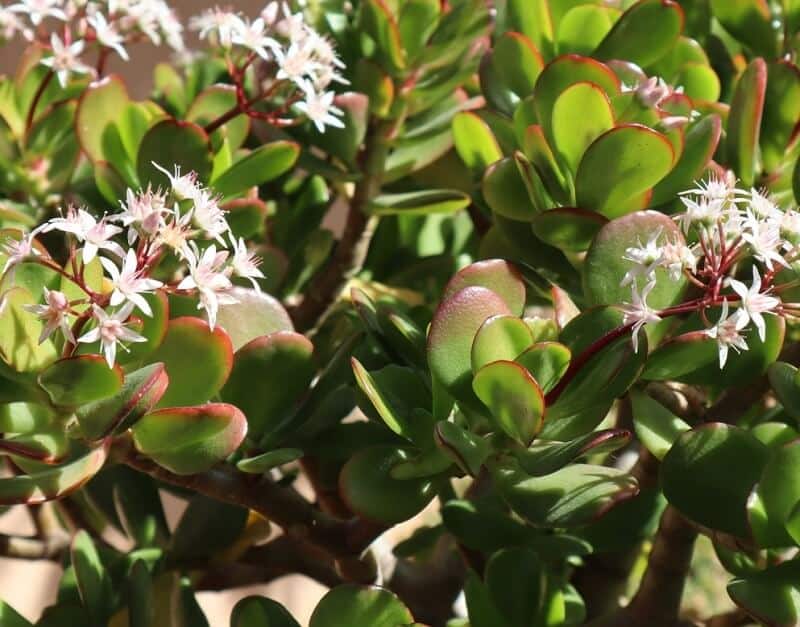
Jade plants are both trees and succulents with ability to purify air in your room.
These large indoor plants easily grow in pots provided that the soil is kept moist. (Only water when the soil is very dry)
Also, the plants can adopt to different light conditions hence you can place them anywhere in rooms.
Moreover, jade plants can tolerate sandy, acidic, slightly alkaline and loamy soils. The soil however, should be fast- draining as these plants hate sitting on water.
Feed your plants with a weak solution of liquid fertiliser once a month during the growing season to maintain their vigor.
Caution: It is important to note that the plant is toxic to pets especially cats and dogs therefore, avoid interactions between the two.
13. Umbrella Plant (Schefflera arboricola) Dwarf
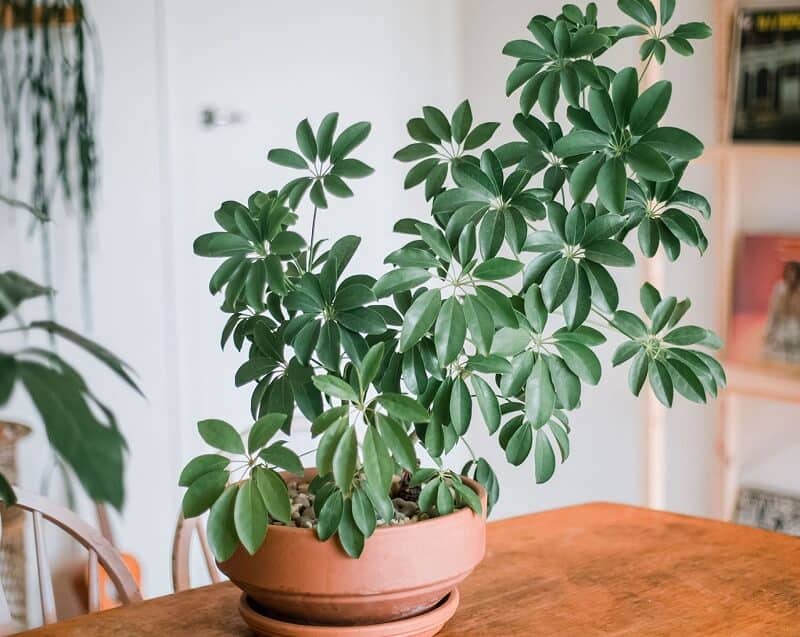
Umbrella plant is an attractive tropical large indoor plant shrub with glossy leaflets that spiral out like spokes on a wheel.
It is a very easy to care house plant that requires bright – indirect sunlight and minimal watering. (water only when the top of soil feels dry).
You can learn more on how to water potted plants.
These indoor plants are great at filtering indoor pollution. Schefflera plants are fast growers and work really hard during the growing season.
Therefore, fertilize your plants on a weekly basis from early spring through summer.
Don’t fertilize in the fall and winter since your plants need some time to rest.
Caution: Umbrella plant is poisonous to humans and pets, therefore be careful with this beautiful indoor plant!
14. Kentia Palm (Howea forsteriana)
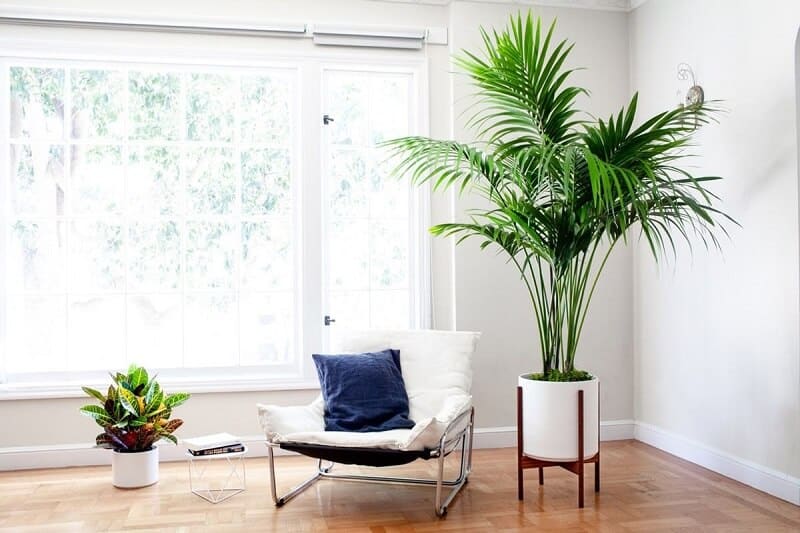
Want an elegance and exotic tropical look indoors? Well, go for kentia palm!
This indoor plant is adaptable to a wide range of soils (clay, sand, loam, slightly alkaline, acidic, well-drained) and is considered to be moderately drought tolerant.
Therefore, only water when the soil feels dry.
However, they do not tolerate severe dryness or continual over-watering, especially during the winter.
Kentia palm prefers bright light but it’s also low- light tolerance.
15. Money Tree (Pachira aquatica)
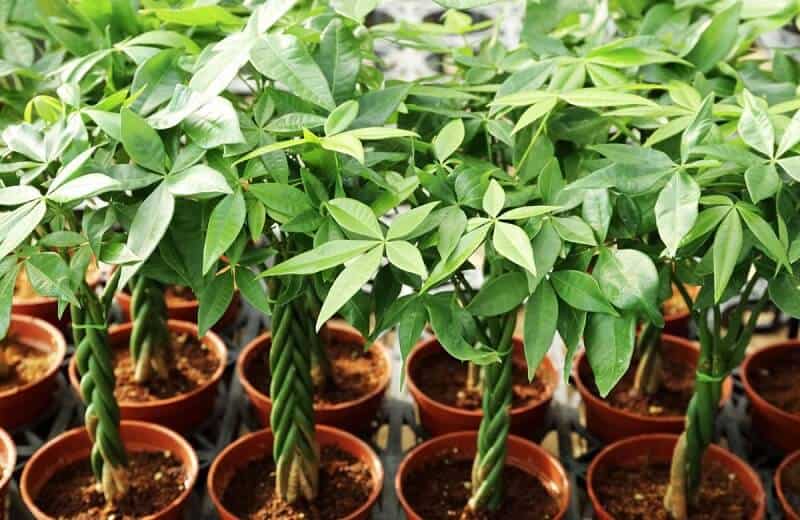
With its twisted trunk and sprawling leaves, money tree definitely brings beauty to your home.
This unique and lovely indoor plant loves medium to bright indirect sunlight and little watering (most preferably once a week or when the top of soil is dry)
Use well-draining sand, peat-based soil for best performance. Loves humidity and can be place near a bathroom.
Feed your money tree monthly in spring and summer when it is actively producing new leaves. You can use a general houseplant food diluted by half.
Also fertilize the plant every second month during autumn and winter if the plant produces new leaves.
Though not proven, money tree is said to bring good luck for finances and maybe this might be just what you need!
Note: Money tree will not harm your pets since it is non -toxic to humans, cats, and dogs.
16. Parlor Palm (Chamaedorea Elegans)
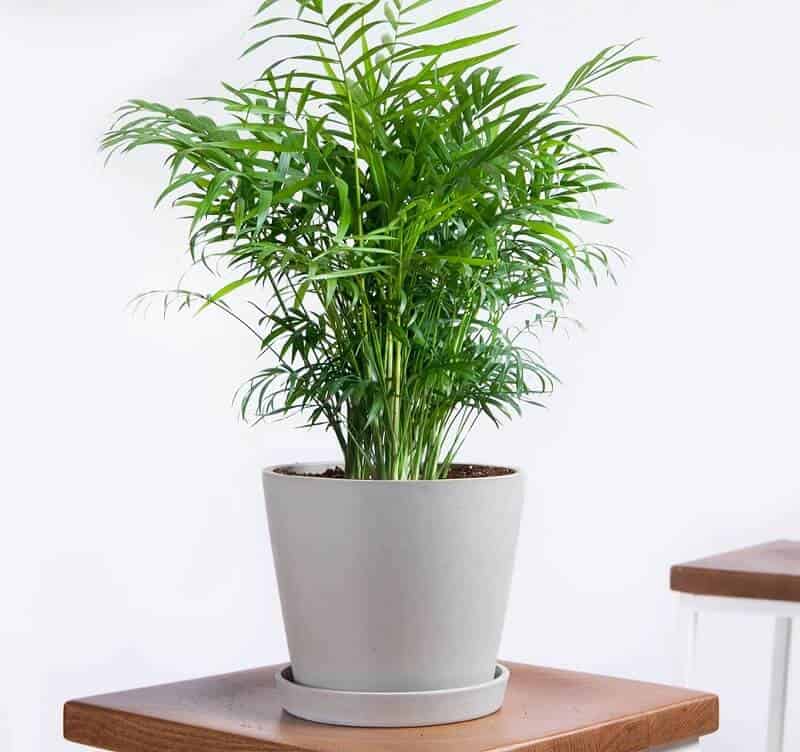
Image Credit: Bloomscape.com
Parlor palms are easy to grow houseplants with low light and water requirements.
Additionally, parlor palms are easily affordable as compared to other palms. Plant your palm in a tall container with a well-drained potting soil for best performance.
Keep your plant healthy by feeding them once every two weeks during the growing season with a liquid fertilizer or fish emulsion.
Pro tip: When applying a fertilizer use half as much as the directions suggests to avoid salt build-up.
Note: This indoor plant is non-toxic for animals and humans.
17. Calamondin Orange Tree (Citrus Mitis)
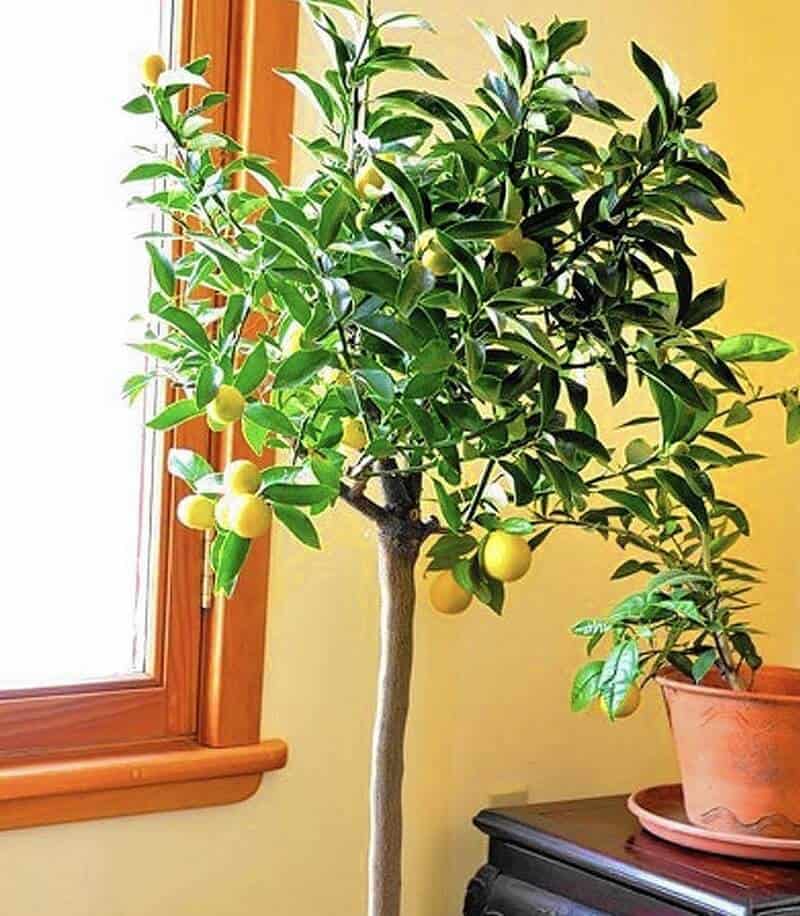
This evergreen indoor tree species produces edible fruits and adds a good lemon fragrance to your home.
Though the calamondin fruits are very acidic and hard to digest, their color adds an amazing touch of beauty to any household.
Bright sunlight is best for good performance but, LED grow lights can also work for those living in places with less sunlight or during winter.
Calamondins are acid- loving plants, so use fertilizers specifically made for such plants. Fertilize your plants only when they are actively growing especially in April through September.
(Always use half the recommended strength of fertilizer to avoid salt build- up)
Caution: Citrus Mitis is toxic to dogs, cats and horses.
18. Pony Tail Palm (Beaucarnea Recurvata)
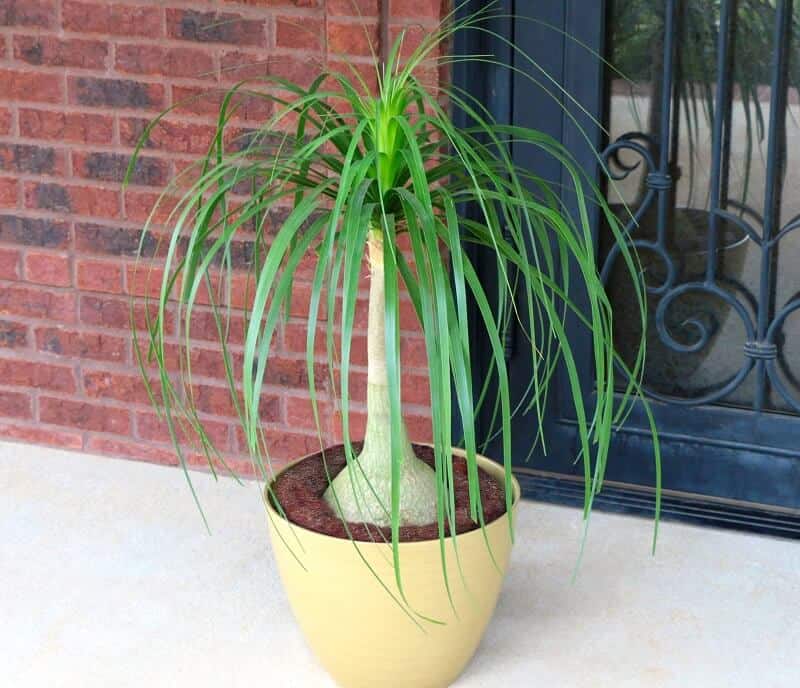
Pony Tail Palms are succulent house plants with elegant eye- catching characteristic.
Their long, strappy leaves and bulbous trunk makes them visually appealing, especially in modern settings.
Due to their succulent nature, watering them lightly even once a week is more than enough. Pony tail palms need full sun to partial shade for normal growth.
As for soil requirements, these indoor plants can tolerate different soil types and conditions ranging from clay, sand, loam, alkaline or acidic.
Just ensure that the soil is well drained.
19. Madagascar Dragon Tree (Dracaena Marginata)
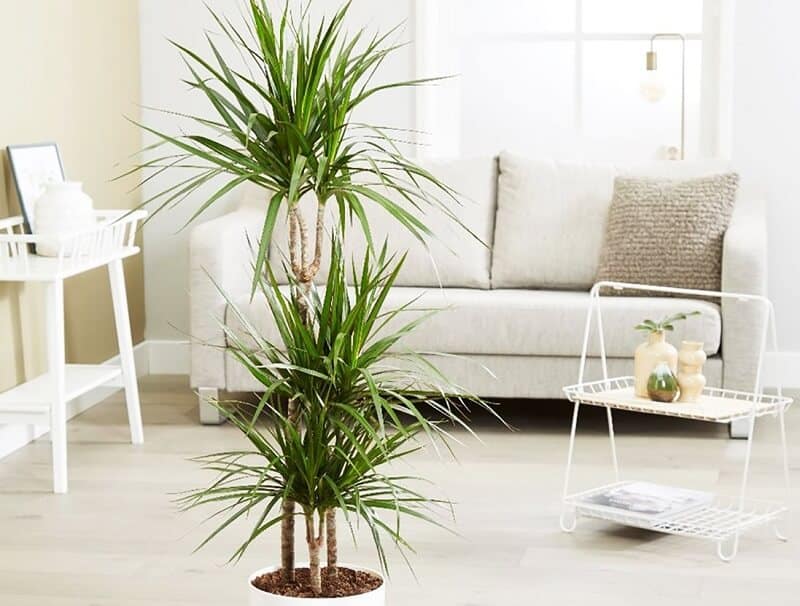
Madagascar dragon tree has long, strappy red -green variegated leaves and slim stalks.
If you are looking for a tall and easy to care houseplant, then this should be your choice!
These indoor plants do well in bright – indirect sunlight but can also tolerate low light, though they may lose their variegations.
Madagascar dragon tree has a low fertilizer requirement, so fertilize in spring, summer, and fall with a controlled-release formula.
Dracaena marginata hates excess water so, water well and do not water again until the top of the soil is completely dry.
Otherwise your plant will die!
Just like many other Dracaenas, this indoor plant is sensitive to fluoride (causes leaf discouration) so use distilled or non-fluorinated water.
Dracaena marginata has been listed by NASA as an excellent plant for removing harmful chemicals from the air. (A reason enough why you should have one in your home)
Caution: It is important to note that Dracaena marginata is poisonous to cats and dogs so be careful with yours!
20. Olive Tree (Olea europaea)
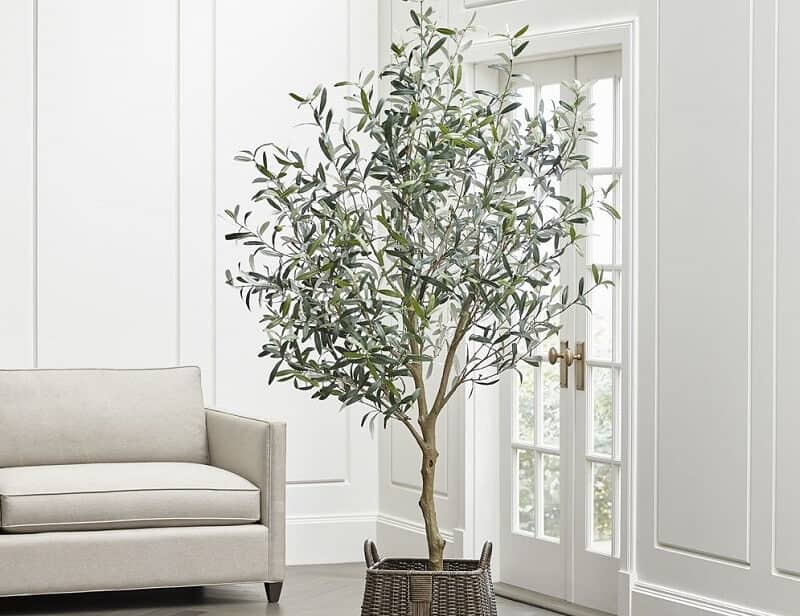
Olive tree is an evergreen fruit bearing tree or shrub that is believed to be one of the longest living.
Olea europaea loves lots of sunlight therefore, the plant is unlikely to flower indoors.
But it’s sage leaves and elegant branches will definitely add an ancient- romantic feel to your home.
Want to enjoy the beauty of indoor olive tree all year round? Then place your plant in a sunny spot where it can get enough sunlight.
Even if it means moving it outside to get the amount of sunlight it need. (At least 6 hours of direct sun a day)
Maintain the good health of your plant by feeding it with a balanced houseplant fertilizer once a month in fall and winter.
Feed your olive tree twice a month in spring or you can switch to a timed-release fertilizer. (Read the label first before application)
Note: Other than all year-round beauty, olive tree is not harmful to pets, therefore no worries.
21. Weeping fig (Ficus benjamina)

Weeping fig is known to be one of the best large indoor plants in improving air quality.
The tree prefers bright indirect light. So, place your plant in front of a sunny window or in a corner of your room away for the window.
Do not keep your tree in front of doors and heating vents because the hot, dry air and cold drafts might lead to leaf fall.
For a healthy tree, feed with a slow release fertilizer at the beginning of summer. This is the time that the tree is actively growing.
However, do not fertilize it during the winter as this is the time for your tree to take the much needed rest.
